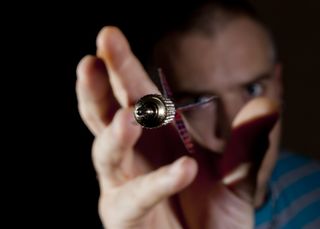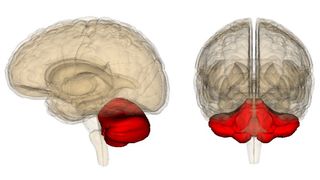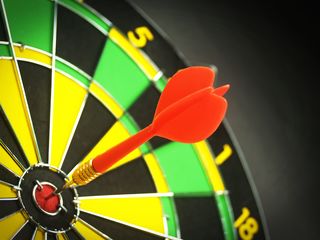Sport and Competition
Cerebellum Helps Us "Know Without Knowing" in Sport and Life
New research identifies how the cerebellum ensures that practice makes perfect.
Posted September 26, 2018
“Skate to where the puck is going, not where it has been. A good hockey player plays where the puck is; a great hockey player plays where the puck is going to be.” —Wayne Gretzky
Ice hockey legend Wayne Gretzky is credited with saying the admittedly overused adage, “Skate to where the puck is going to be,” which has been interpreted literally and figuratively by countless athletic coaches and business entrepreneurs over the years. For example, on the eve of unveiling the game-changing iPhone in 2007, Steve Jobs was quoted as saying, “There’s an old Wayne Gretzky quote that I love. ‘I skate to where the puck is going to be, not where it has been.’ And we’ve always tried to do that at Apple. Since the very, very beginning. And we always will.”

The brain mechanics and motor skills required to automatically "skate to where the puck is going" in the professional sports world are very similar to the real-world motor skills required for doing everyday things like riding a bike to work or driving your car to the supermarket. Some exotic examples of similar motor skills could include navigating a rickshaw through downtown Tokyo in rush-hour traffic or the precise motor skills one might observe in a smoke-filled pub where a Jedi Master of dart throwing with laser focus hits the inner bullseye from across the room every time.
With practice, most people can gain the "explicit" intellectual knowledge of learning how to hit a static or moving bullseye target under various conditions as well as the "implicit" intuitive knowledge of how to perform motor skills automatically and without overthinking.
Generally speaking, explicit motor control involves movements you could describe or learn to perform using declarative language and implicit motor control involves finely-coordinated movements you can only learn to perform with fluidity and precision after lots of practice, practice, practice.
From a metacognitive perspective of the motor skills used to type this blog post: Many touch-typists can type over one-hundred-words per minute without looking down at their QWERTY keyboard. But surprisingly, the majority of expert typists have no explicit or declarative memory of where all of the letter keys are physically located on the keyboard. However, once someone with years of touch-typing experience places each index finger on the braille-like ridges that define the home keys of “F” and “J”— he or she can achieve lightning-fast typing speeds effortlessly.
Because I learned the implicit and explicit motor skills required for touch-typing in high school, I'm rapidly transcribing this stream of consciousness paragraph in the predawn darkness without looking at the keys. Just like the quick red fox jumps over the lazy brown dog, or Wayne Gretzky's hockey skates on ice, my fingertips can glide across the keyboard and accurately strike each letter of the alphabet to complete whole sentences and thoughts faster than my mind can fully process the task at hand.

From a neuroscience perspective, one might ask: What do all of these motor skills involving both the explicit aspects of "knowing" exactly what you want your muscles to do and a more intuitive sixth sense of “knowing-without-knowing” where and how you need to move parts of your body have in common? Cerebellum-based motor learning is the answer.
For the first time, scientists in Japan have identified that human hand-reaching movements rely on two types of motor learning: (1) acquisition of explicit motor control and (2) acquisition of implicit motor control; both of which they believe rely on cerebellum function. The findings of this paper, “Tandem Internal Models Execute Motor Learning in the Cerebellum,” were recently published in Proceedings of the National Academy of Sciences.

For more than three decades, there’s been an ongoing debate among neuroscientists about how internal models of motor learning acquisition work in the brain. One school of thought was that precise motor control in our daily lives and sports depends on an internal model of "learning where to move” (i.e., the calculation of a specific destination for any given motor command). The other school of thought was that mastering the exact timing of fine-tuned motor coordination and precise motor execution relied more on "learning how to move” (i.e., the calculation of a specific motor command necessary to hit a bullseye target).
Depending on one's school of thought, experts would argue that the brain used either one or the other internal model. Interestingly, the Tokyo Metropolitan Institute of Medical Science researchers who conducted this recent cerebellar research have identified that both internal models appear to be necessary for executing precise movements, and both implicit and explicit motor learning seem to involve the cerebellum.
As the authors explain, “In performing skillful movement, humans use predictions from internal models formed by repetition learning. However, the computational organization of internal models in the brain remains unknown. Here, we demonstrate that a computational architecture employing a tandem configuration of forward and inverse internal models enables efficient motor learning in the cerebellum. The model predicted learning adaptations observed in hand-reaching experiments in humans wearing a prism lens and explained the kinetic components of these behavioral adaptations. The tandem system also predicted a form of subliminal motor learning that was experimentally validated after training intentional misses of hand targets.”

For this experiment, lead author Takeru Honda and coauthors had human subjects repeatedly make a hand-reaching movement with their index finger to hit a target on a touchscreen in the bullseye. After mastering this skill, participants were asked to put on a pair of distorting “prism glasses” that shifted their vision a few degrees to the right and tricked their eyes into thinking the target was somewhere that it wasn’t (like a rapidly moving hockey puck). At first, everybody missed the target, as would be expected. But after about 10 tries, people figured out how the "prism lenses" shifted their vision and were able to compensate in ways that allowed them to hit the target precisely in the bullseye without making errors and "without thought."
Again, what makes this study unique is that participants consciously realized they had to make these adjustments using explicit knowledge, but the changes also became automatic via subliminal implicit motor learning. These results suggest that learning “where to move” is necessary for the explicit execution of precise movements whereas learning “how to move” is necessary for the implicit execution of flawless movements.
Notably, the researchers found that people with damage to the cerebellum had deficits in both implicit and explicit types of motor learning. In a statement, the authors said, “Indeed, we found both types of deficits in cerebellar patients by evaluating them by clinical indexes which we developed. Therefore, the applications of this finding may help to develop clinical tests to evaluate learning capabilities of different types of cerebellar patients. The test will help to measure effects of various rehabilitations or novel therapies for cerebellar ataxia. In the field of sports, the present results will also help to develop effective methods of training for top athletes.”
The Universal Cerebellar Transform (UCT) Theory and Dysmetria of Thought
Another recent study on the cerebellum and both motor control and nonmotor functions by Xavier Guell, Jeremy Schmahmann, and John Gabrieli of the McGovern Institute for Brain Research at MIT and Harvard Medical School was posted online September 23 as a preprint. This paper, “Functional Specialization Is Independent of Microstructural Variation in Cerebellum but not in Cerebral Cortex,” advances a hypothesis that cerebellar functional specialization is not determined by microstructure and that cerebellar functions may be computationally constant across domains.
Guell et al. sum up their hypothesis in the study abstract, “The human brain is understood to follow fundamental principles linking form (such as microstructure and anatomical connectivity) to function (perceptual, motor, cognitive, emotional, and other processes). Most of this understanding is based on knowledge of the cerebral cortex, where functional specialization is thought to be closely linked to microstructural variation as well as anatomical connectivity. The Universal Cerebellar Transform (UCT) theory has posited that the cerebellum has a different form-function organization in which microstructure is uniform, and in which functional specialization is determined solely by anatomical connectivity with extracerebellar structures. All cerebellar functions may thus be subserved by a common microstructural — and hence computational — substrate.”
Jeremy Schmahmann, director of the Massachusetts General Hospital Ataxia Unit and pioneering researcher who first identified cerebellar cognitive affective syndrome (CCAS) in 1998, described the significance of this new study on Twitter: “Powerful and novel experimental evidence using brain MRI to support the theories of the Universal Cerebellar Transform and Dysmetria of Thought. That is, cerebellum does the same thing to cognition and emotion that it does to motor control because it is built that way!”
References
Takeru Honda, Soichi Nagao, Yuji Hashimoto, Kinya Ishikawa, Takanori Yokota, Hidehiro Mizusawa, Masao Ito. "Tandem Internal Models Execute Motor Learning in the Cerebellum." Proceedings of the National Academy of Sciences (First published online: June 25, 2018) DOI: 10.1073/pnas.1716489115
Xavier Guell, Jeremy D. Schmahmann, John D.E. Gabrieli. "Functional Specialization Is Independent of Microstructural Variation in Cerebellum but Not in Cerebral Cortex." bioRxiv (First posted online as a preprint: September 23, 2018) DOI: 10.1101/424176




